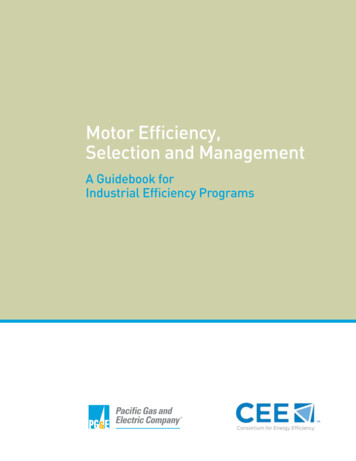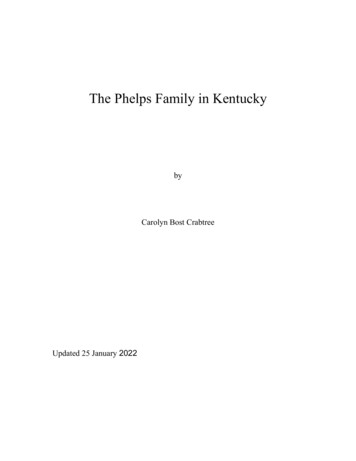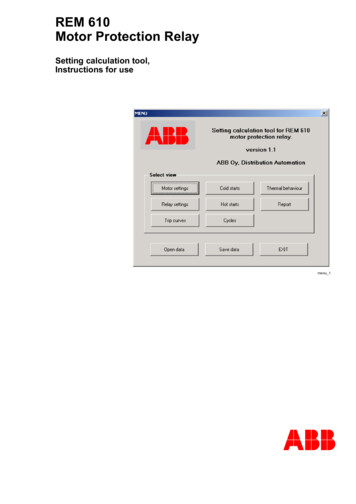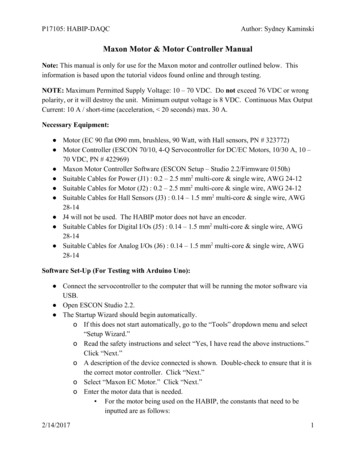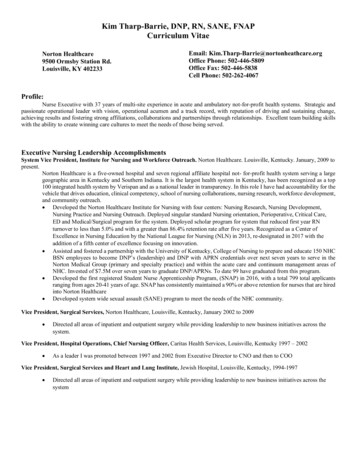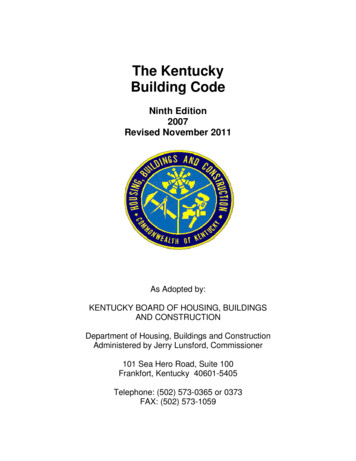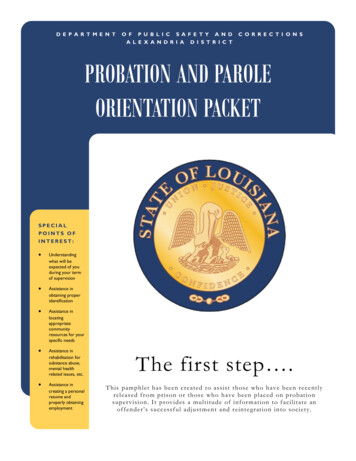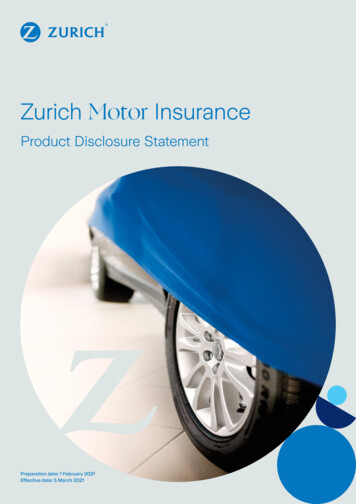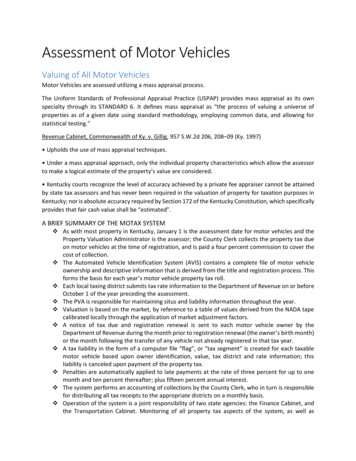
Transcription
Assessment of Motor VehiclesValuing of All Motor VehiclesMotor Vehicles are assessed utilizing a mass appraisal process.The Uniform Standards of Professional Appraisal Practice (USPAP) provides mass appraisal as its ownspecialty through its STANDARD 6. It defines mass appraisal as “the process of valuing a universe ofproperties as of a given date using standard methodology, employing common data, and allowing forstatistical testing.”Revenue Cabinet, Commonwealth of Ky. v. Gillig, 957 S.W.2d 206, 208–09 (Ky. 1997) Upholds the use of mass appraisal techniques. Under a mass appraisal approach, only the individual property characteristics which allow the assessorto make a logical estimate of the property’s value are considered. Kentucky courts recognize the level of accuracy achieved by a private fee appraiser cannot be attainedby state tax assessors and has never been required in the valuation of property for taxation purposes inKentucky; nor is absolute accuracy required by Section 172 of the Kentucky Constitution, which specificallyprovides that fair cash value shall be “estimated”.A BRIEF SUMMARY OF THE MOTAX SYSTEM As with most property in Kentucky, January 1 is the assessment date for motor vehicles and theProperty Valuation Administrator is the assessor; the County Clerk collects the property tax dueon motor vehicles at the time of registration, and is paid a four percent commission to cover thecost of collection. The Automated Vehicle Identification System (AVIS) contains a complete file of motor vehicleownership and descriptive information that is derived from the title and registration process. Thisforms the basis for each year’s motor vehicle property tax roll. Each local taxing district submits tax rate information to the Department of Revenue on or beforeOctober 1 of the year preceding the assessment. The PVA is responsible for maintaining situs and liability information throughout the year. Valuation is based on the market, by reference to a table of values derived from the NADA tapecalibrated locally through the application of market adjustment factors. A notice of tax due and registration renewal is sent to each motor vehicle owner by theDepartment of Revenue during the month prior to registration renewal (the owner’s birth month)or the month following the transfer of any vehicle not already registered in that tax year. A tax liability in the form of a computer file “flag”, or “tax segment” is created for each taxablemotor vehicle based upon owner identification, value, tax district and rate information; thisliability is canceled upon payment of the property tax. Penalties are automatically applied to late payments at the rate of three percent for up to onemonth and ten percent thereafter; plus fifteen percent annual interest. The system performs an accounting of collections by the County Clerk, who in turn is responsiblefor distributing all tax receipts to the appropriate districts on a monthly basis. Operation of the system is a joint responsibility of two state agencies: the Finance Cabinet, andthe Transportation Cabinet. Monitoring of all property tax aspects of the system, as well as
conducting compliance programs, is the responsibility of the Finance and Administration Cabinet’sDepartment of Revenue, Office of Property Valuation.KRS 132.485 - Motor vehicle registration as consent to assess -- Exceptions -- Assessment ofvehicle twenty years old or older -- Ownership -- Assessment of vehicle purchased and registeredin different years -- Exemptions.(1) (a) Except as otherwise provided in paragraph (b) of this subsection, the registration of a motorvehicle with a county clerk in order to operate it or permit it to be operated upon the highways ofthe state shall be deemed consent by the registrant for the motor vehicle to be assessed by theproperty valuation administrator from a standard manual prescribed by the department forvaluing motor vehicles for assessment unless:1. The registrant appears before the property valuation administrator to assess the vehicle; or2. The motor vehicle is twenty (20) years old or older, in which case paragraph (b) of this subsectionapplies regarding its valuation.The standard value of motor vehicles shall be the average trade-in value prescribed by thevaluation manual unless information is available that warrants any deviation from the standardvalue.1.All automobiles, pickups, boats, boats trailers, motorcycles, and recreational vehiclesmust be assessed at the NADA or appropriate guide trade-in value as of January 1 of eachyear. If no adjustments, the AVIS assessment should match the January 1 NADA cleantrade-in value, or the equivalent, in conjunction with KRS 132.485.2. All large (medium and heavy-duty) trucks are assessed at the wholesale value from theNADA Commercial Truck Guide. Much of the equipment on these vehicles, such as dump beds,cranes, etc. qualifies to be listed on the Business Personal Property Tax Return (form 62A500).The truck shall be assessed in MOTAX as the NADA valuation includes only the cab and chassis.Vehicles 19 Years Old or LessThe assessments of automobiles, pick-ups, small trucks, and vans that are nineteen (19) years old or lessare derived from the NADA Official Used Car Guide. All motor vehicles assessed by this guide shall beassessed at the clean trade-in value, less any applicable deductions, unless information is available thatwarrants any deviation from the standard value.Vehicles 20 years or OlderKRS 132.485(b) In the case of motor vehicles that are twenty (20) years old or older:1. It shall not be presumed that a vehicle has been maintained in, or restored to, the original factoryor otherwise classic condition or that its value has increased over the previous year;2. In assessing motor vehicles under this paragraph and calculating the taxes due thereon, throughthe AVIS or otherwise, if the registrant does not appear before the property valuationadministrator to assess the vehicle, the standard value shall be as follows:
a. The actual valuation of the vehicle as was assessed in the vehicle's nineteenth year, if the vehiclewas assessed for taxation in the Commonwealth in that year; orb. The average trade-in value prescribed by the applicable edition of the valuation manual for thevehicle in its nineteenth year, if the vehicle was not assessed for taxation in the Commonwealth inthat year; reduced by ten percent (10%) annually for each year beyond nineteen (19) years; and3. In the case of any motor vehicle for which the assessment procedure provided in subparagraph2.b. of this paragraph would apply but cannot be carried out because the applicable edition of thevaluation manual is unavailable, the property valuation administrator shall conduct an assessmentof the vehicle to determine the value thereof for the given taxable year. The assessment under thissubparagraph may be done in person if the vehicle's owner presents the vehicle at the propertyvaluation administrator's office, or the assessment may be done through a review of photographsand other documentary evidence. In subsequent years, that valuation shall be reduced by tenpercent (10%) annually.Adjustments to NADA Value/Adjustments to AssessmentThe PVA may adjust values based upon the condition of the vehicle on the assessment date of the taxyear. The PVA may adjust the NADA value if the vehicle is not considered to be in average condition incomparison to other vehicles of the same age and make.Adjustment for condition may be one of a combination of the following:Deduct if: Vehicle had high mileage on assessment date (January 1). Maximum deduction: 40% of trade-in value. Vehicle has been wrecked and damage has not been repaired prior to assessment date (January 1). Vehicle value includes options which customer’s vehicle does not contain. Vehicle has a “branded” or rebuilt title. The assessment shall be 60% of the trade-in value. Vehicle has salvage title on January 1 of tax year. The assessment of salvage title vehicles should notexceed 25% of retail value. The PVA should determine this assessment.As of January 1, 1998, no override shall be lower than 26% of the January NADA retail value unless asalvage title has been obtained.CAUTION: Any vehicle assessed at 25% or less of the clean trade-in value shall be considered salvage andremoved from Kentucky highways, pursuant to KRS 186A.335. The owner shall apply for such title withthe County Clerk.Add if: Vehicle has options that are not included in NADA value. Vehicle has low mileage. Vehicle is in superior condition (restored older vehicles).
Documentation Required for Reduction of AssessmentTo adjust for physical or mechanical damage, the PVA must receive an estimate for cost of repairs neededto put the vehicle in average condition. A copy of the estimate should be retained by the PVA. Be remindedthat the condition of the vehicle as of January 1 of the tax year may be the average for such model(depending on age of vehicle).To adjust for high mileage, evidence of high mileage on January 1 of the tax year must be provided. Aservice order of approximate January mileage or an affidavit of the January mileage are two acceptablemeans of documentation. Any vehicle assessed by the NADA Official Used Car Guide may be allowed amileage deduction by using the High Mileage Table in the guide. The high mileage deduction should bededucted from the NADA trade-in value, but it may not exceed 40% of the trade-in value.Diesel engines are identified within the VIN. Refer to the NADA guide, since the presence of a diesel enginemay add to the assessment.Vehicles that have a salvage title on January 1 of the tax year shall be assessed at no more than 25% ofthe January NADA retail value. Owner should present the salvage title to PVA for review.Vehicles with a “branded” title shall be assessed at 60% of the average retail value. The owner shouldpresent the title to the PVA to receive this reduced assessment. The PVA must retain a copy of the title asdocumentation.Errors in assessment due to incorrect Vehicle Identification Number (VIN) shall not require anydocumentation. However, to alleviate the problem of an incorrect assessment each year, the PVA mustinstruct the owner to contact the Clerk for correction of the VIN.Examples of Assessment AdjustmentsVehicles 18 Years Old or LessHigh MileageThe Cabinet recognizes the use of the High Mileage Table in the NADA guide. The PVA may consider highmileage as a basis for value adjustments. However, pursuant with NADA guidelines, the high mileagedeductions shall not exceed 40% of the NADA average trade-in value as of January 1 of the tax year. Thefollowing examples are calculated for the 2019 tax year.Example #12017 GMC Light Duty Acadia Utility 4D SL 2.5L 50,000 milesAverage trade-in value 16,775 (January 2019 guide)High mileage deductionAdjusted assessment 1,275 15,500
Example #22016 Toyota Corolla Sedan 4D LE 1.8L 108,000milesAverage trade-in value 10,625 (January 2019 guide)High mileage deductionAdjusted assessment 2,700 7,925Damaged VehicleDamage to a vehicle on January 1 of the tax year may be deducted from the trade-in value for that year.Damage deductions for parts and materials shall not exceed a professional estimate. The cost of labor isnot included in the damage deduction. A combination of the deductions shall not reduce the assessmentto 25% or less of the average trade-in value.Example #32016 BMW 3 Series Sedan 3D 320i 2.0L 42,500 miles Damage estimate of 3,000Average trade-in value 14,575 (January 2019 guide)Mileage deduction n/aDamage deduction 3,000Adjusted assessment 11,575Example #42010 Nissan Altima Sedan 4D 2.5L Retail: 5,750 150,000 miles Damage estimate of 1,000Average trade-in value 3,075 (January 2019 guide)High mileage deduction 775Damage deduction 1,000Adjusted assessment 1,300In example #4, the adjusted assessment of this vehicle with the high mileage and damage deduction is 1,300. If the assessment stays at 1,300 the vehicle must be removed from Kentucky highways becauseits value is less than 25% of the retail value. In order for the owner to be legal and retain the registrationfor this vehicle, the PVA should assess the vehicle at 1,495, which is 26% of the retail value.Once a vehicle’s value has been adjusted through an override of the NADA valuation, the vehicle’svaluation will be reduced in subsequent years by 10% and boats 5% annually.The “Clean Trade-in” is used in the mass appraisal of motor vehicles because the "Clean Trade-in"value most closely approximates the constitutional standard of fair cash value. This has been
consistently verified through the Department’s system of random sampling of arm’s lengthtransaction motor vehicle sales.Below are the totals for the last 2 years results of the random sample results.Year20202021NADA - dian Clean vs Avg4,254,7254,394,575Sales PriceVTR4,554,7774,878,472#transactions555406It is clear from this data that the “NADA Clean” category provides a much closer approximation of theoverall fair cash value of used vehicles than the “NADA Average” category.The process includes requesting a data file from the Commonwealth Office of Technology (COT) of alltransfers occurring in January.Upon receipt of the file, duplicate transactions are removed. Duplicate transactions include clerk mistakesand transactions involving the same vehicle type based on make, model, year, and value. This is completedin order to ensure the sample is as diverse as possible.The sample size is determined utilizing resources at https://www.surveysystem.com/sscalc.htm.The sampling tool in excel is used to extract the sample.The data analysis begins by looking up the vehicle transaction report (VTR) for sales price and informationto determine an arms-length transaction. Transactions that cannot reasonably be determined to be armslength are removed. These transactions include, but are not limited to: duplicate title requests, salvagetitle requests, no sale transactions, name changes, repossessions, and transactions between relatedparties.The National Automobile Dealers Association (NADA) Has Explained WhyThey Changed “Average” Values to “Clean” Values Beginning in 1995According to the NADA, today's "Clean Trade-In" value is the same as what the NADA Official UsedCar Guide (“NADA Guide”) formerly called both "Average Trade-in" and "Trade-In." The sameapplies to the NADA Guide’s current "Clean Retail" value, formerly named "Average Retail" and"Retail."Historically the NADA Guide used the term "average" to describe both Retail and Trade-in values.Most state statutes that reference an “average” value, including Kentucky’s, were enacted wellbefore 1995. Here is an image from a pre-1995 NADA Guide:On January 1, 1995, the NADA Guide discontinued using the term "average." The editorialmethodology did not change. The NADA Guide simply changed the terms "Average Trade-in" to"Trade-In" and "Average Retail" to "Retail." The stand-alone terms "Retail, Trade-in and Loan,
continued to be used for the next 12 years from January 1, 1995 until January 1, 2007. Here is animage from the January 1995 guide:On January 1, 2007, the NADA Guide introduced the term "Clean" for all three values, reflecting theireditorial position that the condition of a vehicle, as a consistent starting point in the methodology ofvaluation, was clean.Again, their methodology did not change. Here is an image from the January 2007 guide:From January 2007 forward, the pre -1995 "Average Trade-in" and "Average Retail" were nowlabeled "Clean Trade-in'' and "Clean Retail." Same values. Same methodology.On September 1, 2008, the NADA Guide introduced two new conditional values; "Average Tradein" and "Rough Trade-in." The addition of these new cond itional values was based on requests fortheir values to reflect the wholesale side of the market and represented the first time in 77 yearsthat they expanded beyond three traditional values. Currently, the NADA Guide displays fivevalues for each vehicle; “Clean Retail,” “Clean Loan,” “Clean Trade-In,” “Average Trade-in” and“Rough Trade” -in. Here is an image from the October 2008 guide:As this history shows, the "average" value referenced in many state's general statutes written prior to1995, including Kentucky’s, is actually today's "Clean" value as expressed in the NADA Guide.How does a taxpayer protest an assessment?
KRS 131.110 requires a protest of assessment be handled by the Department of Revenue. The PVA isconsidered an employee of the Department of Revenue and is required to expedite the protest on behalfof the Department. The PVA may reassess a vehicle based upon high-mileage or condition of the vehicle.The first step in a protest is for the taxpayer to speak informally with the PVA. If the PVA cannot agreeupon an assessment within the Department’s guidelines, the PVA should instruct the taxpayer to file awritten protest with the Department.All protests must be filed within sixty (60) days of the date of the notice. The assessment is final after suchtime period. Motor vehicle assessments are final beginning with the first day after the renewal month.The taxpayer will be required to provide documentation supporting their claim along with the writtenprotest.Many times taxpayers wait until the last day of the renewal month to protest their vehicle value to thePVA, which can result in additional delinquency fees if the property tax and registration fees are not paidtimely. The PVA should instruct the taxpayer to remit payment of the full amount of property tax andregistration fees owed to the County Clerk prior to the last day of the renewal month. If the taxpayerprevails in their protest, they can receive a refund of any overpayment. Payment of the taxes andregistration fee does not extend the protest period. Sometimes it may take weeks to settle the protest inFrankfort, and if the taxpayer has not timely paid the tax liability and registration for their vehicle, notonly are they are subject to delinquent tax charges, they can be cited by the police for having an expiredregistration.Upon receipt of the protest in Frankfort, the Department will review the documentation and send a letterto the taxpayer with the Department’s decision. If the taxpayer prevails, they can then receive a refund.The County Clerk will be notified of the valuation adjustment and will be provided authorization to refundany applicable overpayment.Protests should be mailed to the Department of Revenue:Department of RevenueMotor Vehicle Section, Division of State Valuation501 High Street, Station 32Frankfort, KY 40601KRS 131.110 Protest of assessment by Department of Revenue – Review – Appeal.(1)1.2.(b)(c)3.(a) The Department of Revenue shall mail to the taxpayer a notice of any tax assessed by it. Theassessment shall be due and payable if not protested in writing to the department within:Forty-five (45) days from the date of notice, for assessments issued prior to July 1, 2018; andSixty (60) days from the date of notice, for assessments issued on or after July 1, 2018.Claims for refund of paid assessments may be made under KRS 134.580 and denials appealed underKRS 49.220.1. The protest shall be accompanied by a supporting statement setting forth the grounds upon whichthe protest is made.2.Upon written request, the department may extend the time for filing the supportingstatement if it appears the delay is necessary and unavoidable.The refusal of the extension may be reviewed in the same manner as a p rotested assessment.
Collection and Payment of taxes related to motor vehiclesThe County Clerk is the collector of motor vehicle taxes pursuant to KRS 134.800.134.800 County clerk to collect ad valorem taxes on motor vehicles registered by him -Acceptable means of payment. The county clerk shall be collector of all state, county, city,urban-county government, school, and special taxing district ad valorem taxes on motorvehicles registered by him. The clerk may accept payment of taxes due by anycommercially acceptable means including credit cards.The due date for motor vehicle taxes and when such taxes become delinquent is outlined in KRS134.810.134.810 Date on which taxes become due or delinquent.(1) All state, county, city, urban-county government, school, and special taxing district ad valoremtaxes shall be due and payable on or before the earlier of the last day of the month in whichregistration renewal is required by law for a motor vehicle renewed or the last day of the monthin which a vehicle is transferred.(2) All state, county, city, urban-county government, school, and special taxing district ad valoremtaxes due on motor vehicles shall become delinquent following the earlier of the end of the monthin which registration renewal is required by law or the last day of the second calendar monthfollowing the month in which a vehicle was transferred.(3) Any taxes which are paid within thirty (30) days of becoming delinquent shall be subject to apenalty of three percent (3%) on the taxes due. However, this penalty shall be waived if the tax billis paid within five (5) days of the tax bill being declared delinquent. Any taxes which are not paidwithin thirty (30) days of becoming delinquent shall be subject to a penalty of ten percent (10%)on the taxes due. In addition, interest at an annual rate of fifteen percent (15%) shall accrue onsaid taxes and penalty from the date of delinquency. A penalty or interest shall not accrue on amotor vehicle under dealer assignment pursuant to KRS 186A.220.(4) When a motor vehicle has been transferred before registration renewal or before taxes duehave been paid, the owner pursuant to KRS 186.010(7)(a) and (c) on January 1 of any year shall beliable for the taxes on the motor vehicle, except as hereinafter provided.(5) If an owner obtains a certificate of registration for a motor vehicle valid through the last day ofhis second birth month following the month and year in which he applied for a certificate ofregistration, all state, county, city, urban-county government, school, and special tax district advalorem tax liabilities arising from the assessment date following initial registration shall be dueand payable on or before the last day of the first birth month following the assessment date ordate of transfer, whichever is earlier. Any taxes due under the provisions of this subsection andnot paid as set forth above shall be considered delinquent and subject to the same interest andpenalties found in subsection (3) of this section.
(6) For purposes of the state ad valorem tax only, all motor vehicles:(a) Held for sale by a licensed motor vehicle dealer, including licensed motor vehicle auctiondealers;(b) That are in the possession of a licensed motor vehicle dealer, including licensed motor vehicleauction dealers, for sale, although ownership has not been transferred to the dealer; and(c) With a salvage title held by an insurance company;on January 1 of any year shall not be taxed as a motor vehicle pursuant to KRS 132.485 but shallbe subject to ad valorem tax as goods held for sale in the regular course of business under theprovisions of KRS 132.020(1) (e) and 132.220.(7) Any provision to the contrary notwithstanding, when any ad valorem tax on a motor vehiclebecomes delinquent, the state and each county, city, urban-county government, or other taxingdistrict shall have a lien on all motor vehicles owned or acquired by the person who owned themotor vehicle at the time the tax liability arose. A lien for delinquent ad valorem taxes shall notattach to any motor vehicle transferred while the taxes are due on that vehicle. For the purposeof delinquent ad valorem taxes on leased vehicles only, a lien on a leased vehicle shall not beattached to another vehicle owned by the lessor.(8) The lien required by subsection (7) of this section shall be filed and released by the automaticentry of appropriate information in the AVIS database. For the filing and release of each lien or setof liens arising from motor vehicle ad valorem property tax delinquency, a fee of two dollars ( 2)pursuant to this section shall be added to the delinquent tax account. The fee shall be collectedand retained by the county clerk who collects the delinquent tax.(9) The implementation of the automated lien system provided in this section shall not affect themanner in which commercial liens are recorded or released.
Example #3 2016 BMW 3 Series Sedan 3D 320i 2.0L 42,500 miles Damage estimate of 3,000 Average trade-in value 14,575 (January 2019 guide) Mileage deduction n/a Damage deduction 3,000 Adjusted assessment 11,575 Example #4 2010 Nissan Altima Sedan 4D 2.5L Retail: 5,750 150,000 miles Damage estimate of 1,000 ""
